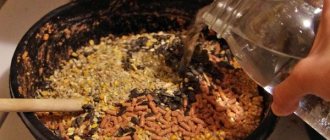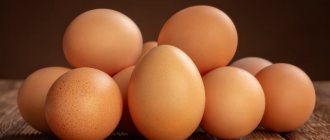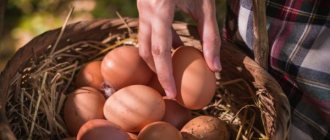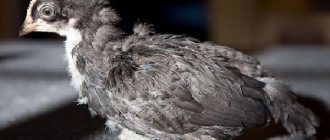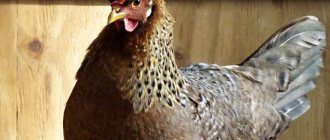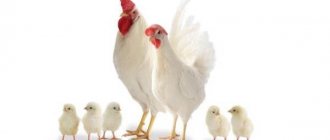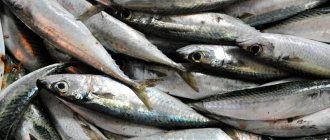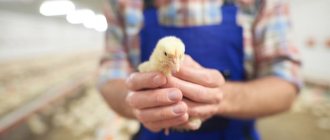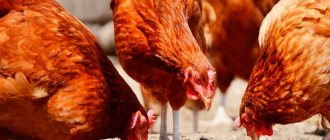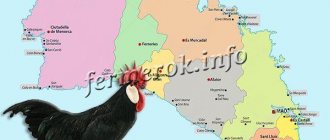What vegetables, fruits, berries and herbs can be given to chickens?
By feeding chickens with all kinds of greens, vegetables, fruits and berries, you can enrich their diet with essential nutrients, saving on expensive concentrated feed.
But it’s not worth feeding the bird everything that comes to hand, and even without any restrictions. Feeding this way can make chickens sick and even die. Before offering laying hens a new treat, you need to know for sure whether it will harm them and in what quantity it should be given. It is necessary to give chickens vegetables. They will enrich their diet with vitamins, minerals, sugars and fiber. There are vegetables that can be fed to birds with almost no restrictions. But there are also those, an excess of which in the diet of laying hens can lead to undesirable consequences.
It is best to give not separately, but as part of wet mash (vegetables should first be washed and chopped: chopped, grated or minced). It is not advisable to subject them to heat treatment, so as not to lose most of the vitamins.
Many vitamins are also lost during winter storage of vegetables, so the healthiest vegetables are fresh.
Boiled potatoes, especially in mashed form, are extremely beneficial for both hens and little chicks. Poultry need not limit its consumption. But the tubers should not have green areas containing a toxic substance - corned beef. If this poison enters the body, it can lead to severe poisoning of the bird. You can also give raw potatoes to chickens. You should beware of sprouted and spoiled ones.
Potato peelings should also be given with caution. It is in them that the largest amount of corned beef accumulates. In addition, this is quite rough food that some chickens refuse to eat.
Under no circumstances should potato tops be fed to laying hens. It contains especially a lot of corned beef. Free-roaming chickens themselves avoid potato bushes. But if, due to the owner’s inexperience, potato tops end up in the hens’ feeder as part of the mash, they may not understand it and be seriously poisoned.
Carrots are an excellent food for poultry, providing their body with vitamin A. You can feed up to 30 g of carrots per day per head.
Just do not forget that chickens do not eat large and tough pieces of this vegetable. It is better for them to chop the carrots finely or grate them. Laying hens eat carrot peelings wonderfully. You can also feed them with carrot tops.
Beets must be used for feeding laying hens with great care:
- It causes diarrhea.
- Beetroot turns the cloaca red, which provokes pecking and cannibalism.
It is better to give chickens not table food, but fodder or sugar beets. The root vegetable can be used together with the tops.
Laying hens enjoy eating cabbage, including fodder cabbage.
A head of this vegetable can be hung in the chicken coop in winter so that the chickens can reach it and gradually pluck it. Or you can offer them finely chopped cabbage leaves mixed with flour.
Since cabbage is easy to keep fresh until spring, it is an indispensable source of vitamins for poultry during the winter. Chickens will not refuse sauerkraut or ensiled cabbage.
All these root vegetables of the cruciferous family can be added in small quantities to mash, after grating them. Tops of root crops should also be used.
Radish is mixed with caution and in the smallest doses, since due to its bitter taste the bird may refuse to feed.
Onions are an essential source of vitamin C in the diet of laying hens. It contributes to the formation of the bird's immunity, protecting its body from diseases, and has bactericidal and anthelmintic properties. It must be given to both adult chickens and chickens from the age of five days. For chickens, onions are passed through a meat grinder, and green onions are finely chopped with a knife.
Do not add excessive amounts of onion to the mash. Its pungent smell can scare away birds. Excessive amounts of onions can cause irritation of the mucous membranes of the digestive tract.
When the fruits of these plants of the Solanaceae family are ripe, small quantities of them can be safely used to feed laying hens. If you offer too many of these vegetables, the chickens will have digestive problems.
You should not feed chickens green eggplants, and especially tomatoes. They, like green potatoes, contain a toxic substance - corned beef. The tops of these plants are also unsuitable for feeding birds.
Fresh cucumbers are an excellent feed for chickens. At first, it is better to offer them to laying hens cut at least in half. Then the chickens will understand that juicy flesh is hidden under the hard peel, and they will even begin to peck at whole cucumbers.
Only the peel of overripe cucumbers is not always suitable for birds to eat.
Pumpkin is extremely beneficial for chickens. Like carrots, it is a source of vitamin A for them. Zucchini will not harm the laying hens either.
Fruits are another excellent vitamin supplement for poultry. Chickens that regularly receive this type of feeding lay eggs with especially bright yolks. But here, too, everything should be done in moderation.
- 1. Apples, pears. At the end of summer and beginning of autumn there is always a lot of carrion in the gardens. These fruits can be fed to laying hens. But you should not give chickens apples and pears often and in large quantities. This will lead to digestive problems. A quarter of the fruit is enough for one head several times a month. You can give not only carrion, but also the cake left over from fruit processing.
- 2. Tropical fruits. Chickens can eat the pulp of oranges and other citrus fruits, but they will refuse the peels unless they play with them. You should not give citrus peels to chickens. There are chickens that happily eat bananas. But there are also those who refuse such fruit.
- 3. Watermelon, melon. Watermelon and melon can be offered to chickens as treats. They happily eat the pulp of the fruit and pick up its seeds (very useful for laying hens). But it is undesirable to overfeed with such pulp; it also causes indigestion. Chickens are reluctant to eat the peels of these fruits. Especially watermelon rinds, as they are too tough and thick for poultry. Some people peck the flesh off them until only a thin peel remains, while others refuse such a treat.
Laying hens love all kinds of berries:
Walking freely around the garden, they easily eat them from lower branches, and are even able to jump to branches growing higher.
But excessive consumption of berries is dangerous for chickens, since their seeds contain hydrocyanic acid, a fairly strong poison.
Greens must be present in the diet of chickens. In the summer they provide for themselves independently, nibbling grass during walks. For the winter, green feeding for laying hens must be prepared. In winter, it will be an important source of vitamins and protein for the bird.
Green food is a source of vitamin K. If there is a lack of this vitamin, bloody spots can be found in eggs. The embryos in them die at various stages of development. In laying hens, capillary strength decreases and anemia develops.
It is best to dry nettles for the winter. It is necessary for both adult chickens and chickens. It contains a sufficient amount of vitamin K, minerals such as iron, copper, zinc and manganese. It is also useful to give dried nettle seeds to birds. For the normal functioning of a chicken’s body, it is enough for her to receive 30-50 g of fresh or 5-10 g of dry nettle per day.
You can also dry alfalfa, clover, pea stems until flowers appear on them (these plants are rich in proteins), chickweed, or as it is also called, chickweed.
Herbs should be harvested away from highways and landfills.
Leaves and needles of trees can be used as green feed for chickens. The needles are harvested from November to February, crushed and added to mash. It will require from 3 to 10 g per day per individual.
Proper feed and grain so that domestic chickens eat well
When keeping and breeding birds on your own plot, you must clearly know the rules for caring for pets. One of the most important points is the rationed distribution of feed. Before feeding the chickens, you need to weigh the required amount.
Such activities will help you avoid obesity or malnutrition. If there is a deviation in one direction or the other, this will negatively affect the overall health of the chickens.
What to do if chickens do not lay eggs is indicated here.
Diet
Industrial poultry farms involved in breeding chickens have long adhered to an optimal nutrition system. It is what promotes rapid productivity. But what about the owner who is engaged in poultry farming at home?
As mentioned earlier, constant undernutrition or overeating has a negative impact on the condition of birds. If foods such as vegetables, grains, and herbs are constantly present in the diet, this will lead to rapid laying of eggs and weight gain. In order for chickens to lay eggs well, you should feed them based on the following menu:
- boiled potatoes – 100 g;
- grain – 120 g;
- cake – 7-8 g;
- wet mash – 25 g;
- bone meal – 2 g;
- chalk – 3 g;
- yeast – 1 g;
- salt – 0.5 g.
Find out what to do if chickens don't lay eggs in winter here.
In the morning, give the birds a wet mash with the addition of bone meal, salt, boiled potatoes, and table scraps. For dinner, it is better to feed chickens whole grains with the addition of products that were not used in the morning. Moreover, a certain amount of grain must be steamed. Then it will be possible to increase metabolic processes and improve the functioning of the digestive system. Cereals should be given every day, alternating.
You can find out what nests for laying hens with an egg collector look like from this article.
Once you have decided on the possible food, you need to determine the permissible dosage. Based on background information, you need to feed the bird in an amount that is selected taking into account its weight. For small individuals weighing up to 1.8 kg, 120 g per day is enough, for chickens weighing 2 kg - 130 g. For every 250 g, the portion increases by 5 g.
Is it possible to give potatoes and raw cabbage?
Geese are fed boiled potatoes at home, and chickens are mixed with beets and raw cabbage. This is a very nutritious and healthy feed. Since these products are given in crushed form, it is necessary to combine them with bone meal to form a wet mash. Such food allows you to quickly satisfy your hunger and saturate the body with all the useful substances that are so necessary for the body to function properly.
Is it possible to feed corn?
Corn is one of the most concentrated feeds, which contains many carbohydrates, vitamins and minerals. They are necessary to maintain the health of the chicken and obtain the required number of eggs. Corn grains are the most nutritious. In addition, they have a yellow color, which affects the color of the yolks. But feeding corn in large quantities is not permissible. Otherwise, the chicken will quickly gain weight and simply become fat.
Such a chicken stops producing eggs. Nutrition should be rational and varied. Corn grains should be included in the general diet. It is best to give them at night. But do not give it raw, but boil or steam it. You can add chopped herbs, peelings and leftover root vegetables, vegetables. Domestic chickens will really like this dinner. She will receive all the necessary microelements, be satisfied and be able to fully rest until the morning.
Is it possible to feed oats?
Oats are one of the best feeds for chickens of all types, including the Jersey Giant breed. It contains a large amount of protein. But this grain has one drawback - its high fiber content. When digesting oats, a large amount of energy is expended, so it is necessary to include only 10% of oats in the feed.
We recommend that you read the description of the Brahma breed in this material.
The use of compound feed for feeding birds, is it possible to make it yourself?
When preparing food for birds, it is important to know what effect each individual component has on the animal’s body. This category includes compound feed. This product can be purchased ready-made in the store or prepared independently. When purchasing a ready-made product, you can be offered two types of products: KK - concentrated feed and PC - complete feed. They differ from each other in composition. When using PC, it is possible to completely saturate the bird’s body with all the necessary substances. If you use CC, you will need to add auxiliary ingredients.
What should you not feed chickens?
They can eat it in almost unlimited quantities, eating almost everything that is given to them. Of course, fresh leaves would be more preferable, although birds also peck pickled cabbage quite well, especially if you add it to dry food and mash.
Let's consider the different uses of this vegetable and its effect on the health of poultry. Fresh cabbage is a good source of vitamins, but in this form it cannot be used all year round. Therefore, in order to stock up on vitamins for the cold season, the collected cabbage leaves are fermented and pickled. With proper preparation and processing of vitamins in such a product there will be only slightly less than in fresh ones, which means that poultry will be able to replenish their reserves. Squeezed and well-washed finely chopped sauerkraut is usually given to chickens as an addition to wet mash or dry food.
Sauerkraut will be equally useful for growing chickens and laying hens, because it:
Greenery
An irreplaceable feed in the diet of chickens, especially laying hens. In summer, the feed mixture should contain 20-30% greens; in winter, this figure is increased to 50%.
It is a source of vitamins B1-B6, C, minerals, and fiber. It is the main supplier of vitamin K to the bird’s body, from which the liver produces blood clotting factors and helps strengthen capillaries.
With its deficiency, vascular permeability increases, and there is a risk of bleeding. The main sign of vitamin K deficiency is the appearance of blood spots on eggshells in laying hens.
Dry greens are introduced into the diet of chickens already in the first week of life. Chicks raised in an incubator should be given 2-3 grams of dry grass already on the 3rd day.
Stinging nettle is a valuable herb for chickens.
Also useful:
- dill;
- parsley;
- alfalfa;
- clover;
- plantain;
- wheatgrass;
- spurge;
- dandelion.
Harmful grasses include:
- elder;
- henbane;
- nightshade;
- ambrosia;
- belladonna
- hellebore;
- burdock.
Grass collected from roadways, household waste dumps, and places with hazardous industries contains harmful substances and carcinogens in large quantities. Therefore, it is unsuitable as food.
Is it possible to feed chickens cabbage?
If there is a lack of vitamins in their usual diet, chickens may eat their own eggs, especially if they have already been damaged. Therefore, if there are empty shells in the chicken coop, it is worth considering the option of feeding cabbage and greens, which can compensate for the lack of nutrients.
Fresh cabbage not only can, but should also be present in the diet of chickens, since it is an excellent source of vitamins. In the simplest version, the head of cabbage is simply hung in the chicken coop at such a height that the chickens themselves can peck the leaves, which they do with pleasure. Finely chopped cabbage leaves can be added to chopped potatoes, beets, or mixed with any other wet mash, since when fed independently, the bird will simply forget about the existence of other food.
In moderate quantities, about a gram of cabbage can be added to 1 kg of feed; such food will be equally useful for all chickens, including laying hens. Among the main features of fresh cabbage are the following:. By periodically adding fresh cabbage to your birds' diet, you will soon notice how their appearance and appetite improve. Did you know?
One egg can contain two yolks at once, but despite this, it will not be possible to get healthy twin chickens. They will either die in the initial stages of development, or a little later, since there are not enough nutrients for two.
If the bird is in normal health, there are no contraindications to feeding cabbage, but as for the amount given out, it’s worth knowing when to stop. When given alone or added to mash in large quantities, stomach upset may occur, although this is uncommon. If the bird already has noticeable problems, then there is no need to aggravate the situation even further and it is better to temporarily abandon cabbage leaves in the birds’ diet.
Can I feed sauerkraut as an additive to the main food?
Meals and cakes from agricultural crops are included in mash and feed for chickens. Earthworms, small species of amphibians and chafers will also serve as a source of protein. Dry feed can also be used to feed laying hens. It is advisable to choose special types intended for chickens and including additives for high egg production.
If poultry is raised for meat, then the feed should not contain various premixes that will reduce the weight gain of chickens. Finished types of feed have nutritional value and composition similar to natural feed. Laying hens are practically omnivorous and can eat food that is not of the best quality. Some breeders, taking advantage of this, try to feed the birds moldy, sour, rotten remains.
This leads to various intestinal infections, diseases, and eating disorders.
Often, with such feeding, fungal diseases of the respiratory system appear. All root vegetables must be chopped before serving. Beets and carrots are fed to poultry in grated, raw form. Potatoes and corn must be boiled to get rid of excess starch. Green potatoes can often poison chickens.
Is it possible to give it to chickens?
Vegetables, grains and greens must be cleaned of dirt and non-food residues: rope, film, foil. You should not feed laying hens baked goods containing sugar and harmful impurities. In small quantities you can give bread from grain crops. All food should not be over-salted.
When feeding fish oil, you need to choose a high quality product to avoid unpleasant odor from the eggs. Excess whole milk can cause dysbiosis in laying hens. You should absolutely not feed your bird the following foods:. This approach allows you to provide chickens with the necessary vitamins, increase their productivity and save on the purchase of feed.
Green food improves the taste and quality of eggs and makes the yolk bright. Grass is easier for laying hens to digest than artificial feed. Alfalfa contains a lot of vitamin A, which has a beneficial effect on vision. Vitamin E, which is rich in sprouted wheat grains, helps improve health and increase productivity. Clover supplies chickens with protein, and sorrel provides vitamin C. Adults love the following types of herbs:.
Chickens eat durum vegetables and legumes well. Cabbage heads and leaves are a good source of vitamins for poultry.
What is best to give to pets?
Since chickens are practically omnivorous birds, it is not surprising that their diet can contain a variety of foods. So, potatoes, legumes, especially peas and beans, as well as fish and even meat trimmings are often added to the usual cereals. Let's find out how useful and appropriate such food will be for chickens. Find out whether and how to give chickens potatoes, peas, salt, onions, beets, oats, bran, grass, garlic, meat and bone meal, fish oil.
Potatoes are a very nutritious product that helps quickly saturate the bird and goes well with other types of food, cereals or herbs. The only thing you should not forget about when issuing it is preliminary heat treatment. At elevated temperatures, the dangerous substance solanine, which is found in large quantities in the peel and upper layers of potatoes, is destroyed. You can start feeding chickens with root vegetables from the 15th day of their life, using first grams of boiled food, and then gradually increasing this amount.
It is better not to give potato peelings, since they are very coarse and take a long time to be digested by the bird’s stomach. Chickens always accept fish and fish products very well, and sometimes they even fight for this type of food.
This is an excellent source of calcium, which will be equally useful for young animals - during the strengthening of bone tissue, and for laying hens - for the strength of eggshells. Of course, we are not talking about feeding fish every day, but it should be added to the diet 1-2 times a week, adhering to the following rules: It is quite difficult to calculate the exact rate of fish consumption by chickens, but on average, to 1 kg of mash you can add - g of chopped boiled product.
Peas are a rich source of vegetable protein, which chickens need just as much as other nutrients. This product is introduced into the diet first in boiled form and in small portions.
Features of feeding in winter - what can be given to birds and what cannot be given
Every farmer notices how chicken productivity decreases in winter. This is caused by the fact that their body lacks certain vitamins. To fill this gap, it is necessary to provide them with all the useful microelements using a properly formulated diet.
This link will help you understand how to determine the age of a laying hen.
As in summer, in winter the diet is based on mixed feed and mash. The number of feeding chickens in winter will be 3 times. The mash is given in the morning and during the day, and the bird is given grain at night. As a rule, grains should be given in crushed form, as they are quickly absorbed and bring positive effects. But it is allowed to give cereal at night; whole grains are suitable. Due to the fact that the digestion of a high-calorie product will take a long time, the chickens will be able to warm up.
Winter food must include wheat bran, sunflower and barley cake, corn, chalk, gravel and premix. Moreover, chalk and gravel must be freely accessible to birds at all times. In frosty conditions it is impossible to find fresh feed, which is so important for normal egg laying of laying hens.
There is a solution, you just need to replace them using the following products:
- Zucchini . The softness of the vegetable is a wonderful delicacy, and the seeds contain a large amount of vitamins and calcium.
- Carrot . If you give this product in crushed form, it will increase the protective functions of the body and activate egg production. This is all achieved thanks to the presence of carotene in carrots.
- Potato . If your potatoes are a little frozen, then the best option to get rid of them would be to include chickens in their diet. The presence of starch in its composition, which under the influence of cold turns into sucrose, allows you to saturate the chicken’s body and energize it.
- Pumpkin, beets . It is also allowed to give any root vegetables growing in your beds.
What not to feed chickens: recommendations from poultry farmers
On average, it is enough to add - grams per 1 kg of other food several times a week. Like peas, beans are also a good source of protein, so they can be present in certain quantities in the diet of chickens.
It is best to add it to wet mash in boiled form, thus complementing potatoes, mixed feed, nettles and other food used. Chickens need a balanced diet no less than people, so if you want your birds to always be healthy, then, if possible, try to diversify their diet as much as possible, including not only cabbage and potatoes, but also all the other named products, of course. adhering to the norm of their issuance.
Laying hens: what to feed so that they lay a lot - nutrition to increase egg production
The productivity of chickens largely depends on the conditions in which they live and what they eat. Both experienced farmers and novice owners of country houses should remember this. Many of them do not take into account proper nutrition, trying to pay more attention to the arrangement of the chicken coop. In this case, you cannot count on high productivity of chickens. But everything can be corrected if you prepare a menu in advance and create a routine. Then you can forget about the problem with low egg production. What should you feed chickens so that they lay eggs well?
Is it possible to ride a scooter with a tractor license?
Is it possible to feed chickens cabbage? Was this article helpful? Thank you for your opinion! Write in the comments what questions you have not received an answer to, we will definitely respond! You can recommend this article to your friends! Poultry farming Chickens Chicken nutrition. You might like it. How to prepare marinade for wings on the grill, six recipes. Chickens of the Ukrainian Ushanka breed: everything about breeding at home.
Arzamas breed of geese: features of breeding at home. Several simple options for constructing a feeder from PVC pipes. Instructions on how to properly feed broilers with compound feed. Technology of raising broiler chickens at a poultry farm. Catalpa tree: benefits and harms, use in folk medicine.
The berries are fresh and not very
Currants, blueberries.
Rich in vitamin C, microelements, flavonoids, tannins.
Currants increase the pH of the stomach to the alkaline side, due to which it has an antimicrobial effect. Removes waste and toxins. Contains a large amount of folic acid, which increases fertility.
It is not recommended to give chickens and laying hens a lot of blueberries - they contain a high content of tannins, which slow down peristalsis.
Raspberries, blackberries.
Contains vitamins B, A, PP, micro- and macroelements (potassium, iron). As well as organic fatty acids and substances that lower the level of fat in the liver.
Be sure to read:
How to feed broilers to quickly gain weight: feed to weight ratio?
In large quantities they cause digestive disorders and impair egg production.
Watermelon.
Watermelon pulp and seeds contain vitamins B1, B2, PP. As well as provitamin A, folic acid, carotenoids, microelements (manganese, potassium, iron). Stimulates digestion and metabolism processes. Strengthen the immune system.
Poultry farmers are often interested in whether it is possible to give watermelon rinds to chickens. They are not harmful to the bird. They have a high content of vitamin E (tocopherols), which increases egg production and is an antioxidant.
Finely chopped peels should be given
Finely chopped peels should be given. Chickens are reluctant to peck large pieces of them.
Other berries
Strawberries, wild strawberries, and grapes are rich in vitamin C. Due to the high sugar content, they activate fermentation processes and promote the development of pathogenic microorganisms. They are given in small quantities.
Gooseberries and rowan in small portions are excellent suppliers of nutrients.
All berries contain hydrocyanic acid, which in large doses causes severe poisoning. It is necessary to avoid stale and spoiled foods in the diet.
Contraindications and harm
Growing globular willow in a summer cottage. How to quickly destroy a tree without cutting it down, chemical methods of removal. Determination of the hunting period for female rabbits. Medicine Beetle: Applications in Medicine and Cancer Treatment. Benefits and breeding of Californian worms. How to make a hammock with your own hands Infrastructure. How long does it last and how to determine the pregnancy of a female rabbit Rabbit breeding. How to prepare tomato paste for the winter: simple recipes for your table Tomato.
What are the benefits of pecans? Plant growing. An orchid's leaves turn yellow: what to do and how to find out the cause of yellowing. Plant growing. The best time to plant tomato seedlings in open ground Tomato. Adromiscus: flower care at home Plant growing. Washingtonia: features of care at home Ornamental plant growing. Subscribe to our blog in Yandex. Zen, there you will always find fresh and relevant information. The use of any materials posted on the site is permitted provided that there is a link to agronomu.
How to serve grass?
Birds can either independently peck greens in the place where they grow, or consume them together with the feed mixture. Experts recommend hanging tufts of grass near the feeding area. This way the chickens won't trample them. As a rule, birds independently choose which greens suit them best. You can safely give them herbal mixtures and weeds. The only exceptions are poisonous plants. In winter, when there is not enough greenery, you can feed the birds dried pine flour and sprouted wheat grains.
Read also: Planting cabbage in open ground, choosing the right location, caring for seedlings - Vegetable garden, Description, tips, reviews, photos and videos
How to feed laying hens in winter
Life is happy in warm countries. Foreign farmers are not interested in feeding laying hens in winter. Some of them manage to do without grain, feed and mash at all. So, Mr. Karl Hammer (video at the end of the material) has been feeding his six hundred corydalis, since 1989, with compost alone. What do the two nutrient heaps that poultry scurry through contain? This is pig, donkey and horse manure mixed with waste from nearby eateries, plus hay and sawdust. Thanks to the last component, the global feeder does not freeze in the American winter cold, and the owner can only harvest chicken eggs every day.
Rules for feeding fish
The norms and rules for including fish in the diet of chickens depend on the age and type of bird. For example, the opinions of poultry farmers on the question of whether raw fish can be given to broilers are divided.
Some feed the bird any fish, including waste and scales, while others are categorically against this. Regarding laying hens, most poultry farmers say that it is impossible to feed them raw fish, as it gives an unpleasant odor to the eggs.
Many poultry farmers continue to feed their chickens fresh fish and claim that this does not have any negative effect on the health of the birds.
In general, you should adhere to the following recommendations from veterinarians and experienced poultry farmers:
- Game fish frozen in blocks can be given as minced meat by adding to wet mash.
- Freshly caught river fish cannot be given raw. Meat and entrails can become a source of helminth infection for chickens.
- It is safer to serve fish boiled. It must be boiled until the bones soften. After boiling, the product must be thoroughly crushed and added to the mash.
Fish in the diet of chickens
Beginning poultry farmers are interested in whether it is possible to give fish to chickens. This product can be included in the diet of chickens, including broilers, starting from the 6th day of life.
- In this case, it must be completely freed from the bones or crushed together with them in a meat grinder. You cannot feed chickens fish with bones, as the chicken can damage the esophagus with the bone.
- Regarding raw fish in the diet of chickens, the veterinarians’ answer is negative.
- Treats for chickens are mixed with cereal or a boiled egg. You need to start this type of feeding with a very small amount, observing the reaction of the chicks.
- If the chickens' droppings have changed, it is necessary to temporarily exclude the product from their diet.
This is interesting: Bobtail cat photo: we explain point by point
Lighting a chicken coop in winter
To create a sunny mood and gentle warmth in a chicken house in winter, one heavenly body is clearly not enough. Not only does it appear in the window much less often than in summer, but in the cold of winter our sun heats the space with great difficulty. To take on part of his worries, the owner of the farmstead needs to have at least a couple of lamps in the chicken coop.
The first, a regular 100-watt or energy-saving lamp, works during the winter thaw or warm December-February days. The second, a thermal infrared lamp, is intended not only for illumination, but also for heating the room in severe frosts. We calculate the power of the infrared device to be 250 W per 15 sq. m area. In winter, we lower such a lamp from the ceiling closer to the chicken kingdom. We put it up for the summer and practically don’t use it, except for days when snow or hail suddenly falls. Actually, there is no need for an ordinary lamp in the summer: the switch starts working only when the daylight hours decrease.
Let me remind you that we remove the lights at night and turn them on about half an hour before feeding the birds. Thirty minutes is enough for everyone to wake up, clean their feathers and at the same time not have time to climb into the nests to lay eggs.
What grass should you not give to chickens?
Poisonous herbs that are prohibited from being given to chickens include night blindness, buttercups, wormwood, hemlock, hellebore, cockle, colchicum, hemlock, and nightshade. These plants contain many toxic substances that can cause poisoning in birds.
You can give celandine to chickens, but in limited quantities. The plant also contains toxic compounds that are harmful to birds.
It is not recommended to use lawn grass for feeding chickens. To destroy natural vegetation, the lawn is treated with herbicides, which are dangerous to the life of chickens.
Feeding laying hens in winter
It’s good that the chicken is not a bear and does not hibernate in winter. Moreover, despite low temperatures, she continues to please her owners and lay eggs. All you need for this is a properly prepared chicken coop, good lighting and proper feeding. Which? Let's figure it out.
Supplement to the diet
In addition to the food itself, the following components must be present in the chicken coop in winter:
A container of water should always be kept in the chicken coop. I will say more - potassium permanganate can be diluted periodically in water to disinfect the bird’s body. Dissolve until the liquid turns light pink.
Shells
We usually add shells from used eggs and sometimes chalk to the basin with shells. In this case, the shells of the eggs from the nests will be strong, and the laying hens will not peck at them. Relatives bring shells from the river that is located near their house. So a product useful for birds appears in our yard completely free of charge. Many chicken owners are concerned that the shell will go into feed too quickly or will remain unclaimed. From my own experience I can say: the bird eats as much of it as the body needs, no more. In order for the substance to be better absorbed, it must be in crushed form. We solve this problem simply. Its components: summer, grandchildren, barbecue, coals and old frying pans. The roasted shell is easily crushed, and the process of preparing it becomes children's entertainment for our entire street.
river sand
A trough with coarse river sand containing pebbles rolled in water is also an indispensable inhabitant of our chicken coop. The stones are known to be beneficial for the digestion of laying hens. In addition, they enjoy swimming in the sand: they clean their feathers and drive out fleas. By the way: in the evening, when the lights are already turned off and the chickens go to the side, I go to them with a flashlight. For what? I send to roost those who got carried away by swimming in the sand and fell asleep in a trough.
A basin of ash, by and large, performs the same function as river sand. It is no coincidence that gardeners use ash, and not sand, to treat their greenery against pests. I think there is a similar effect with chicken fleas. True, such a basin appears in my chicken coop periodically, unlike sand. And the point here is not at all that it is difficult to get: a bathhouse with a stove from a chicken coop, as they say, is at arm's length. But! As soon as ash appears in the chicken house, a holiday begins for the chickens. Smoke is a rocker. The birds enthusiastically splash in this dust up to the ceiling and for some reason drag hay from the floor into the basin. By the way, ash absorbs excess odors in the room, for example, the smell of bird droppings.
Yes, yes, you read that right. Melt water has been popular among chicken owners since ancient times. We don’t give this “ice cream” to chickens every day, but if it starts snowing, then fresh, fluffy, freshly fallen snow is always in the corydalis’ diet. The neighbors even settled on it as a water substitute. Their chicken coop is not as warm as ours, and often the water turns to ice. In this case, snow is probably the only way to provide the bird with the necessary amount of liquid.
Of course, an important component of a winter chicken coop is hay. In my case, I use 2-4 bags per month. We change it every two weeks. In the spring, when we clean the shore of our fish lake, we dry everything that floats above the water and has accumulated under it in the sun. Everything that we remove with a trimmer in late spring and early summer from the shore also goes into winter hay.
Additional feed
Everyone understands that chickens should be fed slightly differently in winter than in summer. Someone goes to a veterinary pharmacy and buys special vitamins. Some people believe that chickens have survived the difficult conditions of their evolution for a reason, and therefore are able to regulate their own life processes in winter. In my version, neither one nor the other is suitable. Feeding laying hens in winter for me is a process born of experimental experiments.
Morning feeding of laying hens in winter
In cold weather morning mash should be supplemented with ingredients that will help poultry overcome winter stress. In addition to the usual vegetables on snowy days, we pay attention to the following products in the menu of laying hens:
Fish + meat and bone meal
For two dozen chickens, add three tablespoons of the mixture to the mash every day. Fishmeal contains protein, and in high-quality flour its digestibility can reach up to 90 percent. In addition, it contains vitamins B2, B3, B12, choline, calcium, phosphorus, iodine. These supplements are valuable when birds are left without walking for several months and vitamins become especially necessary. If your farm prioritizes broilers over laying hens, feeding the same meat and bone meal will be different. Thus, it has been experimentally proven that if broilers are given this additive from 5 to 15 percent of the diet, this will increase the yield of poultry meat by 2.75-3.53 percent.
Shredded pine needles
We also add this element to the mash daily. We grind the bark and needles of all thorny trees that grow nearby: pine, spruce. It is better to prepare in winter, since the concentration of vitamins here is greatest on cold days. The needles expel helminths from birds, and the use of additional chemicals to solve this problem is not required. Add the ground substance to the diet of laying hens: 2 tbsp. for a daily meal.
Nettle
Nettle is also one of the additives that poultry needs in winter. It can be crushed, or it can be untouched and dried. We harvest the grass from mid-May to mid-June, while the nettles are young and juicy. Dry in a dark place. If you prefer the crushed version, proceed in the following way. We peel the dried leaves from the trunks, put them in a bag and crush them. We give it every day at the rate of 10 tablespoons per dish. The benefit of nettle is that it contains iron and manganese, copper and zinc, vitamin C and carotene. In addition, it promotes the healing of wounds, external and internal. As for me, I dry this grass and, without peeling it, hang it in the chicken coop with a broom. This placement forces the chickens to move around once again, stretch their necks, and flap their wings.
Cabbage
All photos from pinterest.com
I also give this crispy delicacy hanging two or three times a month. If you give it more often, you will have to fight chicken diarrhea. Raw cabbage in the coop is really popular, and in return the chickens receive a large amount of vitamins, folic acid, fiber and coarse dietary fiber.
Daytime (evening) feeding of laying hens in winter
In the winter months, we add sprouted oats, barley and wheat to the feed with which we pamper our winged charges. Sometimes we pamper the birds and add half a glass of seeds to the main food: they will disappear from the feeder first.
To germinate wheat, pour (but do not overfill!) some water into them, cover them with paper or a diaper and place them near a heat source. On the second day the sprouts will hatch, the next day we give them to the chickens. The main thing is that the sprouted grains are used before the fourth day of cultivation. In oats and barley, sprouts emerge a little later. Chickens do not need this supplement often; I give it once or twice a week. We also give millet half a liter per feeding three times a week.
Fresh and spoiled fruits
What fruits can be given to chickens?
Apples, pears, plums
They contain a lot of vitamins (B1-B6, C) and microelements (iron). In large quantities they cause digestive upset.
Fresh carrion is suitable for food. 10-12 grams of chopped fruit are mixed into the main food. Such food spoils quickly and is unfit for consumption after 3-4 hours.
Rotten apples and plums contain putrefactive bacteria and are dangerous to the health of the bird. During fermentation, pears release a small amount of alcohol, which is toxic to the body.
Peach, apricot
Contains vitamins B, E, K, PP. Also mineral salts (potassium, phosphorus, zinc), organic acids (malic, quinic). Rich in fiber. Fresh pulp is suitable for consumption. Rotten fruits will cause fermentation in the intestines.
The seeds are poisonous because they contain amygdalin.
Melon
One of the favorite delicacies of chickens. They happily peck both the flesh and the seeds. In small quantities, melon is a source of vitamin C, E, PP and zinc.
Melon is one of the favorite delicacies of chickens.
In large quantities, it causes disruption of food passage and has a toxic effect on the body.
Citrus fruits (oranges, tangerines). Rich in vitamin C. However, they belong to the category of food that birds are reluctant to consume. Chickens peck at the flesh and discard the peel altogether.
Banana
Does not contain substances beneficial to poultry. And the chickens themselves are reluctant to peck its flesh. Banana peel contains dense fibers that can cause esophageal blockage and are difficult to digest.
Candied fruits, figs
They contain a large amount of sugar, which causes fermentation in the stomach. In addition, they are dense, difficult to digest, and clog the gastrointestinal tract.
Unripe figs contain caustic milky juice and are therefore poisonous.
